As the new academic year approaches, schools and educational institutions must gear up for their back-to-school marketing campaigns. Ensuring a strong marketing push can help schools attract, engage, and enroll students more efficiently. In this comprehensive guide, we’ll walk through essential strategies for planning a successful back-to-school marketing campaign.
Understanding the 2024 Back-To-School Marketing Landscape
Before we explore some actionable back-to-school marketing tactics, let’s scope out the landscape by uncovering current trends in the educational marketing landscape.
The Rise of Personalized Marketing
Personalized marketing is becoming vital in the education sector. Why is personalized marketing important in education? Studies show that 79% of students expect personalized experiences from educational institutions. Schools are leveraging AI and data analytics to create tailored content, significantly improving engagement and conversion rates. By focusing on individual student needs and preferences, schools can make their marketing efforts more effective.
Need to kickstart your back-to-school marketing campaign? We can help you implement the latest and most effective strategies. Learn more here.
Increased Focus on Video Content
Video content continues to dominate as a preferred medium for communication and engagement. By 2024, video content is expected to make up 82% of all internet traffic. Schools are investing in video marketing strategies, including virtual campus tours, student testimonials, and live-streaming events, to attract and engage prospective students. This visual approach helps create a more immersive and compelling experience for viewers.
Emphasis on Social Media Engagement
Social media platforms are crucial for reaching and engaging with students. Gen Z and Millennials use platforms like Instagram, TikTok, and YouTube for search, making a social media presence more important than ever. Schools are adopting interactive and engaging social media strategies, including short-form videos, influencer partnerships, and user-generated content, to connect with their audience on a personal level.
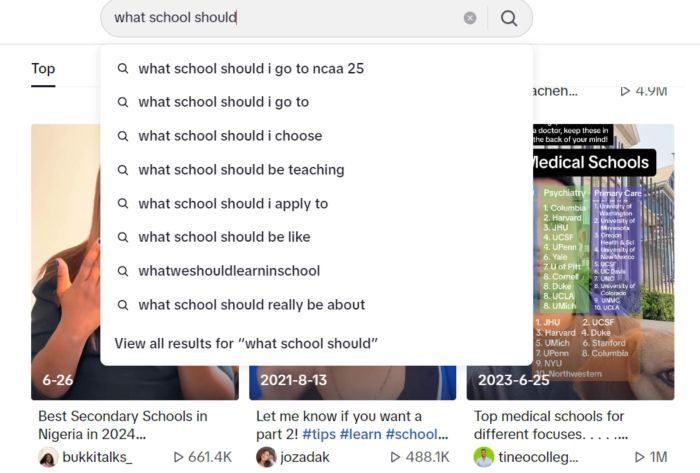
Source: TikTok
Example: Though Google remains an invaluable resource, Gen Z students look for answers on social media platforms like Instagram and TikTok. Remember to use search engine optimization tailored to each respective platform.
Adoption of Marketing Automation Tools
Marketing automation tools are increasingly used to streamline marketing efforts and improve efficiency. The global marketing automation market is projected to reach $8.42 billion by 2027, growing at a compound annual growth rate (CAGR) of 9.8%. Schools are implementing these tools for email marketing, social media scheduling, and lead nurturing, enhancing productivity and delivering timely, relevant content to students.
Adapting to Changing Student Behaviors and Expectations
An effective student retention strategy requires understanding and responding to student preferences. This approach enables institutions to create more engaging marketing strategies, ultimately leading to higher enrollment. Some key trends to keep in mind include:
Ethical Issues and Social Responsibility
Today’s students are more attuned to social responsibility and are more aware of social issues than ever, making these elements crucial in any effective back-to-school marketing campaign. Schools that highlight their commitment to sustainability, diversity, and community involvement not only resonate more deeply with this audience but also build trust and admiration.
As these young minds look to align themselves with institutions that reflect their values, they are drawn to those who actively contribute to social change and foster an environment of inclusivity and ethical awareness. Schools that adeptly communicate these commitments can captivate potential students and their families, making it clear that their educational environment extends beyond academic excellence to shaping responsible, conscientious global citizens.
Flexible Learning Options
In today’s dynamic educational landscape, students increasingly value flexible learning options, a trend schools should emphasize in their back-to-school campaigns. Modern learners seek educational experiences that accommodate their diverse lifestyles, commitments, and learning preferences. They are attracted to programs offering online courses, hybrid formats, and varied scheduling that allow them to balance academics with personal responsibilities.
Schools that highlight their adaptability in providing these flexible learning paths appeal to a broader range of students and demonstrate an understanding of the evolving needs of the education market. By showcasing this flexibility, institutions can position themselves as forward-thinking and student-centered, making them more attractive to potential students looking for an education that fits their unique circumstances.
Mobile and Digital Platforms
As digital natives, today’s students place high value on learning through mobile and digital platforms, a critical aspect for schools to highlight in their back-to-school campaigns. These learners expect seamless technology integration in their education, favoring institutions that offer robust online resources, mobile-friendly content, and interactive learning tools.
Schools that promote their investment in digital classrooms, apps for learning, and online support systems can significantly attract tech-savvy students. By emphasizing their commitment to incorporating cutting-edge technology and digital fluency into the curriculum, schools cater to the preferences of modern students while preparing them for a digital-first world, enhancing their appeal and demonstrating a commitment to providing a contemporary, accessible education.
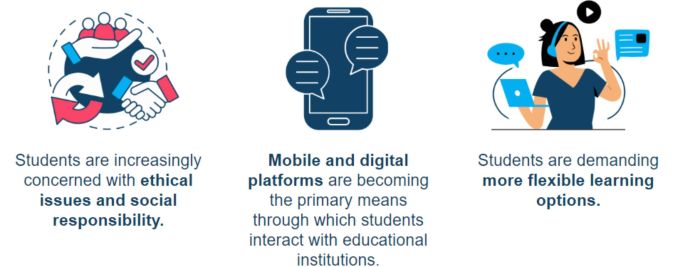
Source: HEM
How can schools adapt to changing student behaviors and expectations? In summary by prioritizing ethical issues and social responsibility, offering flexible learning options, and highlighting any digital learning platforms in your back-to-school campaign.
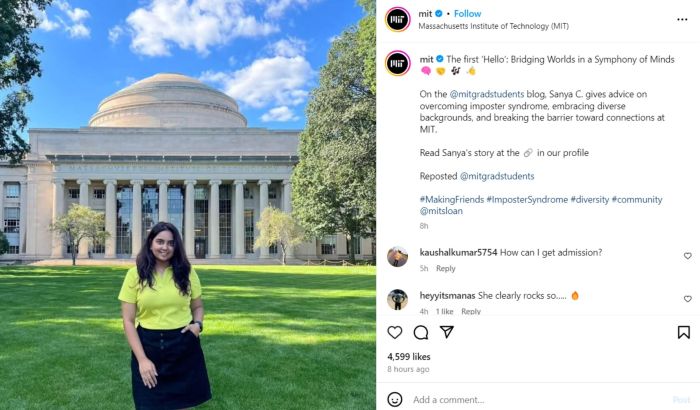
Source: MIT | Instagram
Example: Here, MIT elevates its student’s voices and celebrates diversity in an authentic, personable post. Be sure to demonstrate how your school aligns with the values of today’s students in real, tangible ways.
Essential Marketing Strategies for a Successful Back-to-School Campaign
By implementing the following educational marketing strategies, you build anticipation for the upcoming school year among your community and attract new students.
Start by examining the performance data from previous marketing campaigns. Focus on metrics like conversion rates, click-through rates, engagement metrics, and ROI. Identify which campaigns exceeded expectations and delivered the highest returns. Compile a list of best practices and document challenges and pitfalls to avoid similar mistakes in future efforts.
Setting strategic goals allows for more efficient allocation of resources. Use the SMART criteria to set goals that are Specific, Measurable, Achievable, Relevant, and Time-bound. Ensure these goals support the broader mission and vision of the institution, contributing to long-term strategic goals like enhancing academic reputation, increasing diversity, or expanding international reach.
Implementing Digital Marketing Strategies
Social media continues to be a critical channel for driving awareness, visibility, and interest. Creating engaging content is key. Focus on visually appealing and interactive content, such as videos, infographics, and polls. Utilize social media advertising tools to target specific demographics and interests. Platforms like Facebook, Instagram, and LinkedIn offer advanced targeting options to reach prospective students effectively.
Email Marketing
Craft effective email campaigns with informative and engaging content. Use a mix of text, images, and videos to convey your message effectively. Ensure emails are mobile-friendly and include clear calls to action. Segment your email list based on demographics, behaviors, and preferences to tailor messages to specific groups.
SEO and Content Marketing
Google search campaigns should target lead generation by reaching an audience with high intent. Utilize keywords that potential students are likely to search for and craft compelling ad copy that directs them to your lead generation page.
Conduct thorough keyword research to understand what prospective students are searching for. Use these keywords strategically in your website content. Create high-quality, informative, and engaging content that addresses the needs and interests of prospective students.
Experiment with various content types including blogs, webinars, infographics, images, and of course, videos. Remember that videos are particularly effective due to how easy they are to consume and their shareability. How can schools leverage video content in their marketing campaigns? By showcasing authentic snapshots of your campus life, highlighting your unique facilities and programs, sharing positive testimonials, and of course sharing your videos across all social media platforms.
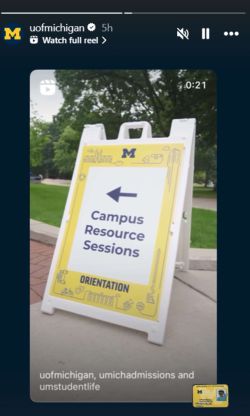
Source: University of Michigan | Instagram
Example: Here, the University of Michigan provides valuable information for new students in their Instagram reels. You can utilize reels, stories, and page posts on various platforms to inform your audience, build anticipation for back-to-school, promote events, and showcase your school’s unique programs and facilities
Leveraging Technology for Enhanced Marketing
The benefits of leveraging technology in marketing are numerous. Efficiency, superior analytics, and personalization come to mind. Discover how to implement various technological tools in your campaign.
Utilizing Marketing Automation Tools
Implement marketing automation platforms like Mautic to streamline repetitive tasks such as email campaigns, and lead nurturing. Use analytics features to monitor campaign performance in real-time, tracking key metrics like open rates, click-through rates, conversion rates, and ROI.
Using marketing automation to run integrated campaigns across multiple channels ensures consistent messaging and efficient use of resources. Platforms like Hootsuite can facilitate social media management and scheduling, providing a streamlined approach to your marketing efforts.
Implementing Chatbots and AI for Engagement
AI-powered chatbots can provide instant support and information to website visitors, handling common queries and guiding users through the site. Chatbots offer 24/7 support, ensuring that prospective students can get answers to their questions at any time, enhancing the user experience, and keeping potential leads engaged.
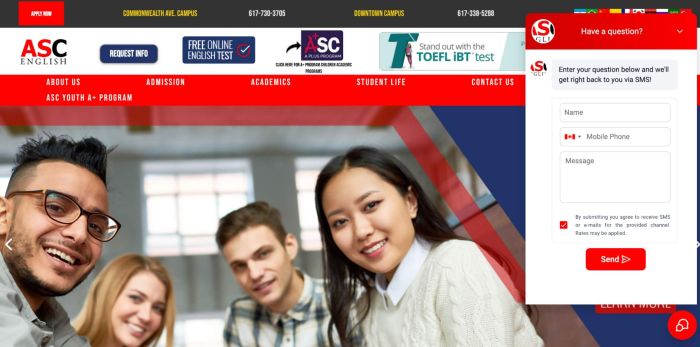
Source: ASC English
Example: Here, ASC English utilizes a chatbot system that conveniently allows prospective students to communicate via SMS. In preparation for a successful academic year, prioritize facilitating communication with prospects and current students.
Addressing Marketing Challenges
During a poll conducted in our webinar, engaging prospective students and gathering marketing assets emerged as significant challenges. A well-organized content calendar following a template (pictured below) can mitigate these issues by simplifying marketing planning and enabling efficient reporting. Content calendars promote consistent scheduling and cohesive messaging which is favorable for growing an audience and getting distributed by various social media algorithms.

Multi-Platform Testing
Your marketing materials must be tested across all platforms—mobile, desktop, and tablet—to ensure a consistent and accessible user experience. Prospective students expect flawless performance, regardless of the device they use.
Marketing Prep Made Easy
Though there are many marketing strategies to consider as you plan your school’s back-to-school campaign, getting started doesn’t have to be overwhelming. Simply follow these steps throughout the planning process:
1. Set SMART Goals
Setting goals that are Specific, Measurable, Achievable, Relevant, and Time-bound (SMART) is crucial for successful marketing campaigns. Align your ad campaigns with your school’s goals and mission to ensure a cohesive strategy.
A school could set SMART goals for its campaign by aligning the campaign objectives with its overall mission of providing accessible, high-quality education. For example, a school could aim to increase the enrollment of under-represented students in its STEM programs by a specific percentage within the next academic year.
To achieve this, their ad campaign could focus on showcasing success stories of diverse alumni, highlighting scholarship opportunities, and promoting the inclusive learning environment of the school. By targeting specific demographics with tailored content and monitoring engagement and conversion rates, you can ensure that your campaign is measurable and time-bound, directly contributing to its broader mission of fostering diversity and inclusion in education.
2. Content Calendar Development
Plan your marketing campaigns with specific content ideas for each week. Develop a comprehensive content calendar to identify key events and topics for the school year and plan content around these.
Celebrating new and incoming students can create a sense of community and excitement. A proposed timeline for using display campaigns and Google search ads can help target appropriate periods for student recruitment.
3. Event Promotion
Identifying key events that require promotion is crucial for schools to enhance their visibility and engagement with prospective students and their families. Events such as open houses, orientations, and special programs are pivotal opportunities to showcase the school’s offerings, culture, and community. These occasions allow potential students to experience the campus atmosphere firsthand, meet faculty and current students, and gain a deeper understanding of the educational and extracurricular activities available.
To maximize the impact of these events, schools should employ a dual strategy of organic promotion and paid advertisements. Organic promotion involves leveraging the school’s existing channels, such as its website, email newsletters, and social media accounts. These platforms can be used to post updates, behind-the-scenes content, and personal stories from students who have benefited from these events, creating a narrative that resonates with potential attendees.

Source: University of Jakarta International | Instagram
Example: In an engaging Instagram video post, the University of Jakarta International promotes its open house. They showcase their state-of-the-art facilities, their teaching methods, and their programs. In your event promotion posts, focus on stirring excitement while sharing useful information.
4. Gathering New Assets and Update Old Ones
Gather new videos, photos, and other marketing assets to ensure relevance by mixing new elements with some reuse of old materials. Regularly update marketing materials to keep them engaging and current. Remember that marketing efforts to retain students will require continuous monitoring.
5. Competitor Research and Understanding Digital Behavior
Knowing what your competitors are doing and understanding the digital behavior of your target audience is essential. This research can provide insights into effective strategies and highlight areas where your school can differentiate itself.
Conducting competitor research is a strategic process that helps you understand your market position and identify opportunities for growth and differentiation. By identifying your competitors, gathering information, analyzing their strengths and weaknesses, and monitoring their marketing strategies, you can determine how your marketing campaign will aim to set your institution apart.
Preparing for back-to-school marketing involves a strategic, multifaceted approach. From lead generation and email marketing to SEO and content planning, each element plays a pivotal role in your campaign’s success. Incorporate AI and data analytics, maintain ethical and social responsibility, and ensure accessibility and consistency in your branding. By following these strategies, you can create a compelling marketing campaign that resonates with your target audience, ultimately leading to successful student recruitment.
Frequently Asked Questions
Question: Why is personalized marketing important in education?
Answer: Studies show that 79% of students expect personalized experiences from educational institutions.
Question: How can schools adapt to changing student behaviors and expectations?
Answer: In summary by prioritizing ethical issues and social responsibility, offering flexible learning options, and highlighting any digital learning platforms in your back-to-school campaign.
Question: How can schools leverage video content in their marketing campaigns?
Answer: By showcasing authentic snapshots of your campus life, highlighting your unique facilities and programs, sharing positive testimonials, and of course sharing your videos across all social media platforms.







